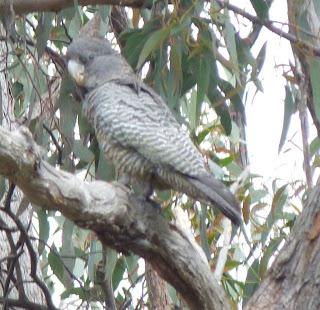ANPS goes to Gossan Hill
The name Gossan Hill reflects a geological formation on the Northern side of the hill. I don't think anyone has done a song about this!
It was back home time for Frances and I today as we went back to the area we lived in for about 15 years. However we don't remember the area ever looking like this: it was in the main brilliant. We could not recall ever seeing the area so covered with flowers. That is shown by this image of an area our leaders called "The Meadow". The main species visible are yellow Dillwynia phylicoides and white Brachyloma daphnoides
In other bits, where the RFS (Rural Fire Setters) had been active it was not so good. This is particularly as what will grow back is most likely not something like the Meadow, but a heap of highly flammable Cassinia or Daviesia. Hardly hazard reduction.
A close up of Dillwynia phylicoides.
The Acacia buxifolia was about at its use-by date.
Chrysocephalum apiculatum.
Stypandra glauca
The most florid samples of Daviesia mimsoides were covered in this strange white filamentous material. I first thought it was spider silk, but now wonder about it being a mycelium. Comments welcome!
A Stylidium graminifolium floret!
A very lush Glycine clandestina.
Dichelachne micrantha, looking unusually interesting for a grass.
Lets get into some more attractive monocots! A very flamboyant Petalochilus fuscatus.
We felt this white not-caladenia was Stegostylus cuculatus
Brown stems appeared to indicate Diuris pardina ...
... while green stems suggested D. nigromontana had slipped across from Black Mountain.
While I was battling through a thicket of Acacia genistifolia Masumi looked down at my feet and as a result spotted three Pterostylis nutans!
Very close to our old house was this huge patch of Glossodia major.
There was a reasonable crop of birds around today. It was particularly pleasing to see a few of the big old dead trees allowed to stand so Gang-gang cockatoos had nest hollows to investigate.
Ms Gang-gang was on supervisory duty - probably because the investigator looks, by his crest to be a bit young.
A bit further on this was clearly a male at the height of his luridness.
He did realise that he also needed to do some work on a hollow.
The next image shows him really getting down and dirty!
This poor photo of an Eastern Rosella does show the lurid colouration of that species.
Right at the end of the walk this Red Wattlebird decided to flaunt its wattles!
It was back home time for Frances and I today as we went back to the area we lived in for about 15 years. However we don't remember the area ever looking like this: it was in the main brilliant. We could not recall ever seeing the area so covered with flowers. That is shown by this image of an area our leaders called "The Meadow". The main species visible are yellow Dillwynia phylicoides and white Brachyloma daphnoides
In other bits, where the RFS (Rural Fire Setters) had been active it was not so good. This is particularly as what will grow back is most likely not something like the Meadow, but a heap of highly flammable Cassinia or Daviesia. Hardly hazard reduction.
A close up of Dillwynia phylicoides.
The Acacia buxifolia was about at its use-by date.
Chrysocephalum apiculatum.
Stypandra glauca
The most florid samples of Daviesia mimsoides were covered in this strange white filamentous material. I first thought it was spider silk, but now wonder about it being a mycelium. Comments welcome!
A Stylidium graminifolium floret!
A very lush Glycine clandestina.
Dichelachne micrantha, looking unusually interesting for a grass.
Lets get into some more attractive monocots! A very flamboyant Petalochilus fuscatus.
We felt this white not-caladenia was Stegostylus cuculatus
Brown stems appeared to indicate Diuris pardina ...
... while green stems suggested D. nigromontana had slipped across from Black Mountain.
While I was battling through a thicket of Acacia genistifolia Masumi looked down at my feet and as a result spotted three Pterostylis nutans!
Very close to our old house was this huge patch of Glossodia major.
There was a reasonable crop of birds around today. It was particularly pleasing to see a few of the big old dead trees allowed to stand so Gang-gang cockatoos had nest hollows to investigate.
A bit further on this was clearly a male at the height of his luridness.
He did realise that he also needed to do some work on a hollow.
The next image shows him really getting down and dirty!
This poor photo of an Eastern Rosella does show the lurid colouration of that species.
Right at the end of the walk this Red Wattlebird decided to flaunt its wattles!



























Comments